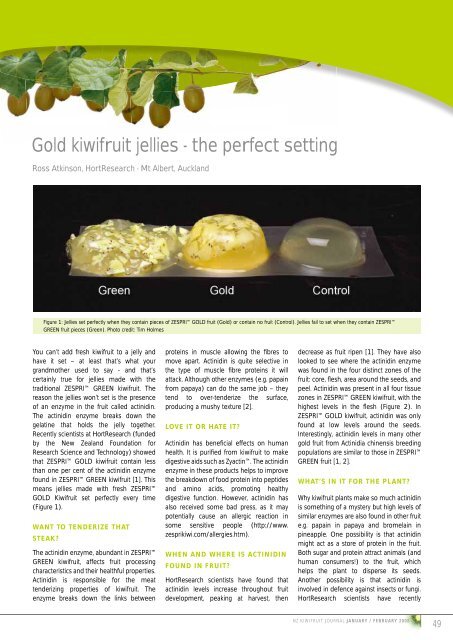Thirsty vines Summer girdling Compost teas Organic marketing The ...
Thirsty vines Summer girdling Compost teas Organic marketing The ...
Thirsty vines Summer girdling Compost teas Organic marketing The ...
You also want an ePaper? Increase the reach of your titles
YUMPU automatically turns print PDFs into web optimized ePapers that Google loves.
Gold kiwifruit jellies - the perfect setting<br />
Ross Atkinson, HortResearch - Mt Albert, Auckland<br />
Figure 1: Jellies set perfectly when they contain pieces of ZESPRI GOLD fruit (Gold) or contain no fruit (Control). Jellies fail to set when they contain ZESPRI<br />
GREEN fruit pieces (Green). Photo credit: Tim Holmes<br />
You can’t add fresh kiwifruit to a jelly and<br />
have it set – at least that’s what your<br />
grandmother used to say - and that’s<br />
certainly true for jellies made with the<br />
traditional ZESPRI GREEN kiwifruit. <strong>The</strong><br />
reason the jellies won’t set is the presence<br />
of an enzyme in the fruit called actinidin.<br />
<strong>The</strong> actinidin enzyme breaks down the<br />
gelatine that holds the jelly together.<br />
Recently scientists at HortResearch (funded<br />
by the New Zealand Foundation for<br />
Research Science and Technology) showed<br />
that ZESPRI GOLD kiwifruit contain less<br />
than one per cent of the actinidin enzyme<br />
found in ZESPRI GREEN kiwifruit [1]. This<br />
means jellies made with fresh ZESPRI<br />
GOLD Kiwifruit set perfectly every time<br />
(Figure 1).<br />
WANT TO TENDERIZE THAT<br />
STEAK?<br />
<strong>The</strong> actinidin enzyme, abundant in ZESPRI<br />
GREEN kiwifruit, affects fruit processing<br />
characteristics and their healthful properties.<br />
Actinidin is responsible for the meat<br />
tenderizing properties of kiwifruit. <strong>The</strong><br />
enzyme breaks down the links between<br />
proteins in muscle allowing the fi bres to<br />
move apart. Actinidin is quite selective in<br />
the type of muscle fi bre proteins it will<br />
attack. Although other enzymes (e.g. papain<br />
from papaya) can do the same job – they<br />
tend to over-tenderize the surface,<br />
producing a mushy texture [2].<br />
LOVE IT OR HATE IT?<br />
Actinidin has benefi cial effects on human<br />
health. It is purifi ed from kiwifruit to make<br />
digestive aids such as Zyactin. <strong>The</strong> actinidin<br />
enzyme in these products helps to improve<br />
the breakdown of food protein into peptides<br />
and amino acids, promoting healthy<br />
digestive function. However, actinidin has<br />
also received some bad press, as it may<br />
potentially cause an allergic reaction in<br />
some sensitive people (http://www.<br />
zesprikiwi.com/allergies.htm).<br />
WHEN AND WHERE IS ACTINIDIN<br />
FOUND IN FRUIT?<br />
HortResearch scientists have found that<br />
actinidin levels increase throughout fruit<br />
development, peaking at harvest, then<br />
decrease as fruit ripen [1]. <strong>The</strong>y have also<br />
looked to see where the actinidin enzyme<br />
was found in the four distinct zones of the<br />
fruit: core, fl esh, area around the seeds, and<br />
peel. Actinidin was present in all four tissue<br />
zones in ZESPRI GREEN kiwifruit, with the<br />
highest levels in the fl esh (Figure 2). In<br />
ZESPRI GOLD kiwifruit, actinidin was only<br />
found at low levels around the seeds.<br />
Interestingly, actinidin levels in many other<br />
gold fruit from Actinidia chinensis breeding<br />
populations are similar to those in ZESPRI<br />
GREEN fruit [1, 2].<br />
WHAT’S IN IT FOR THE PLANT?<br />
Why kiwifruit plants make so much actinidin<br />
is something of a mystery but high levels of<br />
similar enzymes are also found in other fruit<br />
e.g. papain in papaya and bromelain in<br />
pineapple. One possibility is that actinidin<br />
might act as a store of protein in the fruit.<br />
Both sugar and protein attract animals (and<br />
human consumers!) to the fruit, which<br />
helps the plant to disperse its seeds.<br />
Another possibility is that actinidin is<br />
involved in defence against insects or fungi.<br />
HortResearch scientists have recently<br />
NZ KIWIFRUIT JOURNAL JANUARY / FEBRUARY 2008<br />
49


